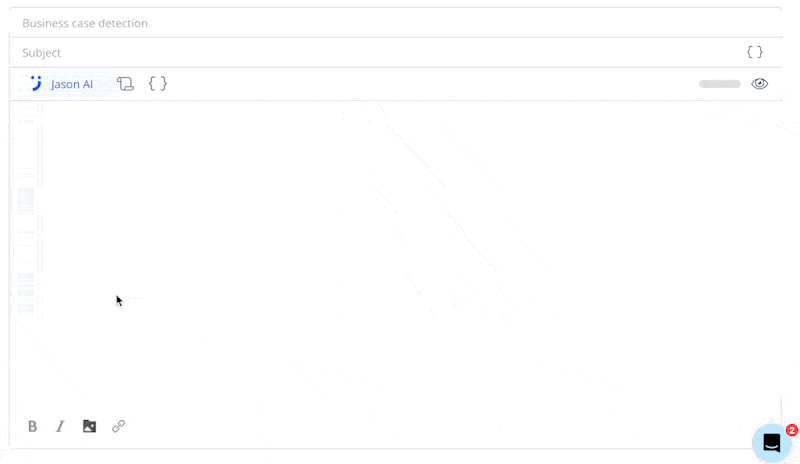20+ proven ChatGPT prompts for sales teams
It’s practically impossible to cover all the potential ways you can use tools like ChatGPT for sales development. There are new, creative ways to use AI for sales-related tasks and unique prompts salespeople come up with based on their specific needs and preferences.
Yet most of the prompts used by SDRs will look like this:
-
- Write an email/LinkedIn message to {persona} about {purpose}
- Personalize the email below based on {data points}
- Generate {5/10/15} variants of subject lines for an email
- Suggest a P.S. text for the email below in {language}
- Translate the email below to {language}
- Improve email to follow the {style/format} of the {example}
- Rewrite the email below in {style/tone/language}
- Make the email below shorter than {number} words
- Write an email follow-up based on the call summary {notes}
And this is perfectly fine! As long as you get what you need and include any important details, as discussed above.
For example, the ready-to-use prompt we would use to create a targeted cold email would be: “Write a cold email to a prospect in the {industry} industry and with job title {job_title}. Find problems related to this industry and generate solutions based on value proposition {value_proposition}. Keep the email within 100 words. I know prospect data — use it for personalization: company is {company}, first name is {first_name}, last name is {last_name}. Act as salesperson, name – {user_name}, company – {user_company}.“
However, there are situations where you will have to get creative and use more sophisticated frameworks to get the job done with AI. Here are some examples of such prompts from sales and AI practitioners.
Thibaut Souyris, one of our favorite sales AI experts (and invited speaker at our upcoming Sales AI Marathon) shared his set of go-to prompts for prospecting in a recent LinkedIn post.
- Find prospect problems: Act like [prospect name], the [job title] at [company]. List your top 3 challenges for 2023. Bullet point and concise answer only.
- Find problem symptoms: Now list 3 symptoms for each challenge above. Bullet points and short answers only.
- Generate email subject lines: Here are 10 email subject lines that got my attention: [examples] Act like a top-performing SDR and generate 10 new outbound prospecting email subject lines based on the ones above. Be short and creative, and focus on teasing the prospect’s curiosity.
- Generate cold outbound messages: Now I’d like to build a 9-touchpoint outbound sequence in order to get [prospect name] to reply to my prospecting. I use the following framework for each message: [framework] Based on the framework I shared, build a cold outreach message for each symptom listed above.
- Turn a marketing resource into a prospecting resource: Act like an online marketer and turn the following content into a playbook: {summary}
Another outstanding expert, Heather Murray, shares her creative Chain of Thought prompting technique for ICP research.
- Start with a pretty straightforward prompt: “Act as a business consultant. I’m the Director at a lead generation agency, and I’m looking to launch a new high-end lead generation product for the aerospace industry. Let’s start by discussing some initial ideas that would work — ask me any relevant questions to flesh this out into a strong idea and the beginnings of a plan to launch it.”
- Build on this with the second prompt in the same thread: “Great, now let’s explore the people that would be most interested in this new product. What job titles would they have, and why might they be interested in the product?”
- Dig a bit deeper: “Tell me more about the pain points of people with these job titles in the aerospace industry. List pain points commonly experienced, and match my solution to their pain.”
If you need, you can go on like that, building on each previous response in the same chat until you have all the responses you need. This is a perfect approach for optimizing your value proposition and targeting, brainstorming new approaches, or fine-tuning your current tactics.
Lastly, Jake Dunlap, CEO of Skaled Consulting (and an expert speaker at the Sales AI Summit) shared various prompt scenarios in his recent webinar on LinkedIn.
He points out that ChatGPT is mostly used for research and writing messages, but this isn’t the only use case sales teams can benefit from. Instead, he suggests incorporating ChatGPT into your SDR onboarding/training strategy. There are a few possible scenarios here.
- Objections handling: “Act as {buyer persona} and give me 5 objections which I will try to counter.” After that, you can also ask AI to tell you how you did and come up with some more objections for you to handle.
- Role-playing: “I want you to impersonate {role} in {industry} and I want to role-play a sales meeting with you. A typical sales meeting looks like this {summary}. Here’s what our product does {value prop}. Let’s go!”
- Scenario planning: “I have a call coming up with {persona} discussing {topic}. I’m trying to think of any reasons they might say no. Help me think through navigating a meeting where I’m talking about {proposal}.”
Over to you
As you can see, there’s nothing too difficult about AI prompting. Once you know the basics and play around with your AI tool of choice, you can find the magic formula to get the desired output.
If you’re not into experiments or don’t have the time to learn effective AI prompting, you can choose AI tools that offer a more seamless user experience.
For example, one of the latest product enhancements for Jason AI — our built-in sales email assistant — is a smooth, intuitive way to optimize your prompts so you can get exactly what is needed every time.

The feature is available in Beta at the moment, but you can sign up with Reply anyway to explore the available AI-powered capabilities and be the first to know when it goes public.






![How to Write Your Perfect LinkedIn Connection Message [With 15+ Templates] How to Write Your Perfect LinkedIn Connection Message [With 15+ Templates]](https://reply.io/wp-content/uploads/linkedin.messages-1024x538.jpg)